|
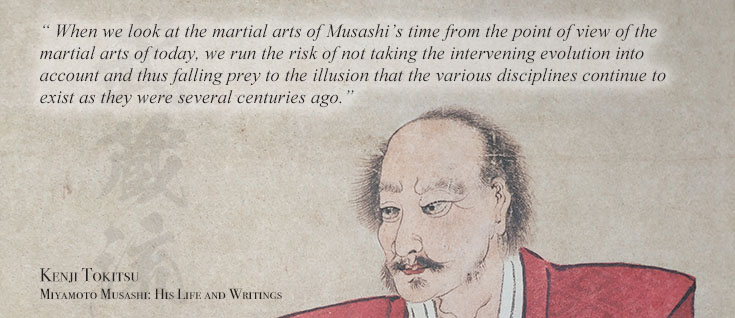
Musashi’s Chūdan-no-kamae.
An inevitably-discussed aspect for practitioners of Miyamoto Musashi’s Nitō-ryū kenjutsu, which is found in both Enmei-ryū and Niten Ichi-ryū, and other independent schools that also have connections to Musashi’s teachings, is the apparent key difference between what is referred to as Enkyoku-no-kamae (also called Gasshō-no-kamae [1]) and Ensō-no-kamae in relation to the fundamental and paramount Chūdan stance.
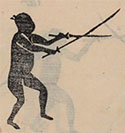 For the sake of simplicity, Enkyoku-no-kamae can be described where the tips of both swords are crossed or, in other words, the swords are joined and touching towards the tips. This style of crossed-sword guard is still utilised in Enmei-ryū as well as Shintō Musō-ryū [2], and also referenced in denshō (transmission documents) of Mikawa Musashi-ryū, a former school that had direct connections to Musashi’s teachings within the Honda-han. For the sake of simplicity, Enkyoku-no-kamae can be described where the tips of both swords are crossed or, in other words, the swords are joined and touching towards the tips. This style of crossed-sword guard is still utilised in Enmei-ryū as well as Shintō Musō-ryū [2], and also referenced in denshō (transmission documents) of Mikawa Musashi-ryū, a former school that had direct connections to Musashi’s teachings within the Honda-han.
Comparatively, Ensō-no-kamae can be described as a guard where the tips of the long and short swords are not crossed or joined: the two swords’ tips remain separated with an opening between them, as practised in all present-day Santō-ha and Noda-ha transmissions of Niten Ichi-ryū [3].
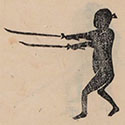 Considering the contrast in the obvious and visible variation, the following premise or hypothesis is usually proposed by proponents of Niten Ichi-ryū’s Ensō-no-kamae: that these differences merely account for earlier and later transmissions of Musashi, and that the Ensō-no-kamae is the refinement of Musashi’s life’s work and culmination of the actual Nitō methods from his final years in the Higo domain. That is, Ensō-no-kamae may be representative of the Chūdan stance within Musashi’s ultimate work, Gorin-no-Sho. Considering the contrast in the obvious and visible variation, the following premise or hypothesis is usually proposed by proponents of Niten Ichi-ryū’s Ensō-no-kamae: that these differences merely account for earlier and later transmissions of Musashi, and that the Ensō-no-kamae is the refinement of Musashi’s life’s work and culmination of the actual Nitō methods from his final years in the Higo domain. That is, Ensō-no-kamae may be representative of the Chūdan stance within Musashi’s ultimate work, Gorin-no-Sho.
Rather than positing the above hypothesis based on conjecture or just Gorin-no-Sho itself [4], it’s perhaps a little more prudent to maintain a broad perspective and viewpoint, as Musashi so often admonished within his teachings. Further, a holistic investigation across his related works and other historical accounts may assist to facilitate a more substantiated determination on the matter.
In any event, Gorin-no-Sho doesn’t clearly describe the two swords of Chūdan being crossed or uncrossed and open. Rather, it does emphasise the importance of the tips or points of the swords being directed or trained toward the opponent’s face, a characteristic that both Ensō-no-kamae and Enkyoku-no-kamae can employ and, in fact, share as a principle.
Looking at the earlier transmissions and extant teachings within the remaining distinct lines of Enmei-ryū and other schools that have connections to Musashi’s Nitō teachings, there’s clearly demonstrable evidence of a crossed-sword chūdan guard (Enkyoku-no-kamae). There are also accounts of encounters between Musashi and others, such as Miyake Gunbei, which reference Musashi’s use of a crossed-sword guard within the Chūdan stance.
Of course, the above can be conveniently dismissed with the suggestion that Enkyoku-no-kamae is simply an earlier method or the old way, and Musashi later modified it to what is currently transmitted as Ensō-no-kamae in Niten Ichi-ryū. Thus far, no written or pictorial evidence of Ensō-no-kamae as currently taught has been found in accounts from Musashi’s epoch, and the naming convention itself appears to date from the Taishō or Shōwa-period.
There are also several issues to take into consideration in relation to the hypothesis that the final teaching of Musashi is the use of Ensō-no-kamae within the Chūdan stance.
First, we should consider Musashi’s likely third adopted son, Takemura Yōemon (also called Takemura Musashi, and Hirao Yōemon). In late 1644, only 6 months or so before Musashi's death, and at a time when he was no longer able to train due to health issues, Musashi dispatched Yōemon to Owari (Nagoya) to transmit the recent developments or refinements that had been made to his teachings. Yōemon had been a disciple of Musashi for a decade or more, following him from Akashi to Kokura, and finally to Kumamoto, before being sent to Nagoya to become a chief retainer and sword instructor within the Owari fief [5].
Obviously Yōemon was intimately familiar with the evolvement of Musashi's teachings, including the latter years of refinement, and was also given a copy of Hyōhō Sanjūgo Kajō (Hyōhō 35). Further, the Owari Enmei-ryū list Takemura Yōemon in their transmission line from Musashi, and therefore, that particular school should be presumed to include the key fundamental aspects of these later transmissions or improvements to Musashi’s ‘Nitō Ichi-ryū’ (as it was known at that time). Importantly, within this extant line of Enmei-ryū, the key Enkyoku-no-kamae or crossed-sword guard remains within the Chūdan stance [6].
Then, most crucially, there’s the actual written descriptions of Terao Kumenosuke (Motomenosuke) Nobuyuki, the single source of transmission in both the present-day Santō-ha and Noda-ha lines of Niten Ichi-ryū.
Among Musashi researchers and scholars there seems to be a clear consensus that, in fact, it was Kumenosuke who, in 1666, added descriptions of the five Nitō forms to Hyōhō 35, which had been bequeathed to him by Musashi. These additions are currently found in Hyōhō 39 (sometimes referred to as Hyōhō 42) and it was this document that was used as proof of transmission within the earlier Higo lines of Niten Ichi-ryū and, not Gorin-no-Sho [7].
Even more recent research, which will be touched upon later, further suggests that the descriptions used for the present-day equivalents of Jōdan, Gedan, Hidari-wakigamae and Migi-wakigamae by Kumenosuke, in Hyōhō 39, were based on an earlier transmission document of Musashi from 1638. In fact, that research indicates it was only the Chūdan stance that Kumenosuke solely authored without any influence from earlier works of Musashi. This is the original Japanese of Hyōhō 39 for the Chūdan stance.
一、 喝咄切先返 中段 切先返。敵合遠き時は、ひつさげ、敵の刀とどかぬ程により、身を真向に直に立て、右の手、前に出し、 太刀大小の刃を余りたてず、ひらめず、少しすじかえて、ふところを広く、少し大小を組みたる様に中段にもつ時、 余りつき出さず、ひぢをかがめず、越さず、右の太刀先少し上る心にて、敵の中筋に有ように構え、 心ざしの心を軽く、心の心を残し、敵打出す心を請け、敵の打太刀にあたらざる如く、向の顔に突かけ、 敵に巧みを失わせ、是非もなく打つ処を、切先を返して、上より手を打つ也。
其の太刀前に捨てたる如くひつさげて、我が身を動かさず、敵又打ちかくる処を、三分一にて下より手を張るものなり。 惣別、敵が打つ也と思う心の頭に我が心を付けて、先々の先になるものなり、 此の太刀何れも出合う也。能々分別すべし。
In the English-language translation of Kenji Tokitsu’s Miyamoto Musashi: His Life and Writings [8], the relevant text that specifically relates to the Chūdan-no-kamae is presented as follows:
You raise your arms, with your elbows neither raised nor lowered, and cross your large and small swords in a forward position and at a middle level, broadly but without putting them too far forward. The point of the large sword is tilted slightly upward and placed above the line that runs between the middle of your body and your opponent’s. The blades of your swords are neither raised nor held flat on the horizontal. They should be held on an angle.
From the original Japanese, the phrase ‘少し大小を組みたる様に中段にもつ時’ has a more literal translation of ‘when holding at chūdan like the daishō (large and small sword) are joined a little.’
The key Japanese word used here is Kumi (組み). Essentially, Kumi is to join separate things together. It has a nuance of joining together separate things that must be physically touching each other, but are not affixed together permanently.
The simplest and most straightforward example of the use of the Kumi is in the example of crossed arms, called Udegumi (腕組み). Also, the use of ‘joined a little’ would infer it’s only a small amount of the swords, such as the tips or monouchi section, that are joined.
Considering the above explanation, you can see why the author chose to interpret and translate this to actually mean ‘cross your large and small swords’ given there’s already a clear pre-existing example, within Enmei-ryū and others, of such a teaching in Musashi’s Chūdan stance.
So, even the initial Hosokawa-han successor to Musashi’s Niten Ichi-ryū and the ultimate source of both the present-day Santō-ha and Noda-ha lines, Terao Kumenosuke (Motomenosuke), is describing the Chūdan stance as like the joining a little bit of the long and small swords together; as is the case with Enkyoku-no-kamae rather than, as a contrast, the Ensō-no-kamae that only has the points coming nearer to each other. Interestingly, the points coming nearer to each other but not joined or touching is similarly described for the Gedan stance only within the same Hyōhō 39 (Hyōhō 42) document.
Furthermore, Prof. Uozumi Takashi of The Open University of Japan claims another document – the Heihō-kakitsuke [9] – was written by Musashi in 1638, at a time when Musashi was in his mid-fifties and living in Kokura with his adopted son, Iori, who was a retainer of the Ogasawara clan. This claim is based on an analysis of the text and various quotations that appear in subsequent texts circulating among the earliest students of Musashi’s school, and would make the document a technical guide and transmission licence for his students at that time.
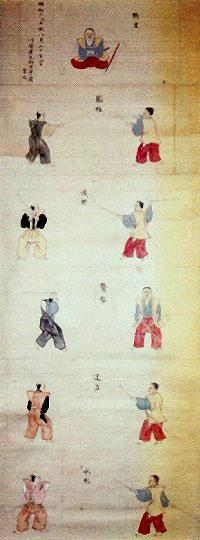 This document was recently translated into English and published for the first time by Dr Alexander Bennett in his book, The Complete Musashi: The Book of Five Rings and Other Works [10]. Dr Bennett describes the Heihō-kakitsuke as a missing link between Musashi’s earlier swordsmanship and what was passed on after his death. However, for me it provides a rather important connection to a missing link in a set of rare drawings from the middle of the Edo period depicting the five Nitō stances connected to a line of Niten Ichi-ryū. (pictured right) This document was recently translated into English and published for the first time by Dr Alexander Bennett in his book, The Complete Musashi: The Book of Five Rings and Other Works [10]. Dr Bennett describes the Heihō-kakitsuke as a missing link between Musashi’s earlier swordsmanship and what was passed on after his death. However, for me it provides a rather important connection to a missing link in a set of rare drawings from the middle of the Edo period depicting the five Nitō stances connected to a line of Niten Ichi-ryū. (pictured right)
Several years ago, when this scroll was found at a small Museum of Art in Niigata Prefecture, the late Suzuki Kōji sensei from the Harima Musashi Kenkyūkai was called upon to examine some photographs of it. The drawings were created in 1769 and originally it was a horizontal scroll that had been subsequently cut and rearranged vertically so it could be displayed as a hanging scroll.
At that time, Suzuki sensei posited that the drawings would have been based on a source document from the leaking of some Higo documents in the mid-18th century due to the naming conventions of four of the kamae being identical to those in Hyōhō 39, despite the fact they are incorrectly mismatched in those Higo documents [11].
Although Suzuki sensei did also indicate, at that time, that it was not possible to identify which line of Niten Ichi-ryū the drawings were based on and, due to the fact that the labels of the last four kamae were actually correctly represented for each kata in the picture scroll, he did feel that the drawing must have been based on another unknown document that had leaked from the Higo domain.
Suzuki sensei concluded the following: ‘By the way, if we were to continue this investigation, it would be that the source document must have existed for the creation of the drawings. From the point of view of the Higo’s original document, that [source document] would be an incorrect version after the leak, if the document has the 'Enkyoku' added to 'Gidan', 'Shigeki', 'Uchoku', 'Suikei' it is likely that that document is the source of the drawing.’
As a result, it would seem most likely that Musashi’s 1638 Heihō-kakitsuke is the source document that Suzuki sensei refers to, given the complete naming conventions and correct labelling order in Heihō-kakitsuke are identical to the drawings in the picture scroll. And, consequently, the line of Niten Ichi-ryū these drawings would likely represent is from just prior to Musashi moving to Higo (Hosokawa clan's Kumamoto fief) in January 1640.
It is recorded elsewhere that, during his several years in Kokura, Musashi taught Nitō Ichi-ryū (as it was called then) and that a line of transmission, which was commonly referred to later as Iori-den Niten Ichi-ryū, continued to be transmitted in Kokura and is presumably connected to this picture scroll.
For interest, below is an image of this Niten Ichi-ryū Chūdan stance labelled ‘Enkyoku’ as well as the initial introductory text of Dr Bennett’s relevant English translation below [12].
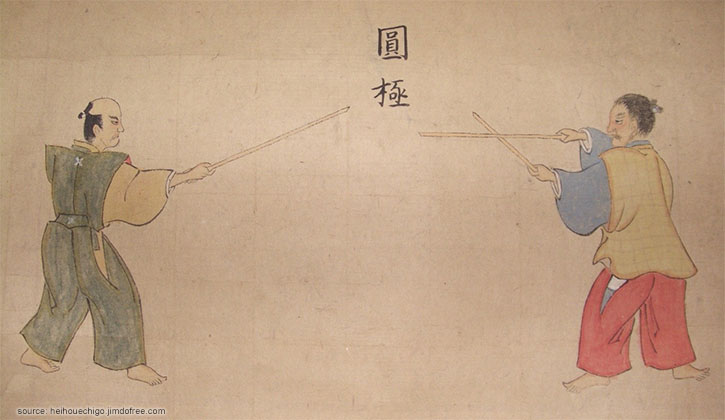
1, Enkyoku Tachisuji-no-Koto (一、円極太刀筋之事)
Employed against all sword attacks, the sword pathway of enkyoku (middle stance) is broad and is also the most fundamental.

To summarise, there are several considerations in relation to the evidence of the utilisation of a crossed-sword guard in Musashi’s Chūdan stance:
- Extant teachings within schools founded by individuals that had connections to Musashi which still use the crossed-sword guard in the Chūdan stance, such as Musō Gonnosuke who, according to Kaijō Monogatari, purportedly became a deshi in 1609.
- A written account from Nihon Kendōshi of Musashi, while staying at Himeji, duelling with Miyake Gunbei at the request of Lord Honda Tadamasa in 1617 with crossed-swords in the Chūdan stance.
- Another account from Mukashibanashi of Musashi, while visiting Nagoya in 1632 as a guest of Terao Naomasa, engaging in two demonstration duels for Lord Tokugawa Yoshinao using crossed-swords in the Chūdan stance with the tips trained towards the nose or directed towards the face of his opponents (both deshi of Yagyū Hyōgonosuke (Toshiyoshi)).
- A rare pictorial example of crossed-swords in the Chūdan stance, albeit from 1769, connected to Iori-den Niten Ichi-ryū and presumably based on Musashi’s 1638 transmission document, Heihō-kakitsuke, while teaching and living in Kokura.
- Yōemon, Musashi’s third son and deshi for a decade or more, moving to Nagoya in late 1644, at Musashi’s request, to transmit to the Owari Enmei-ryū group the recent refinements, noting this school continue to use a crossed-sword guard in the Chūdan stance.
- The 1666 written description of the Chūdan stance in Hyōhō 39 with crossed-swords provided by Terao Kumenosuke, Musashi’s initial principal successor within the Hosokawa clan.
There is also the often over-looked Reishiki (ceremonial manners) connected to a school’s body of Kata. In koryū schools that involve multiple denshōsha (transmitters) which have inherently had several lines of transmission, where lines have split and merged more than once over generations, like those of Shintō Musō-ryū, there can be rather large variations within the waza and kata as it evolves and is influenced over time. Also, within other schools that also have had generational influences and additions made to the curriculum’s body of kata, often distinguished as honden, naiden and gaiden transmissions, there can be also various differences in waza and interpretations between the lines of transmission. And, then there is extant Isshi-sōden (sole succession/single transmitter) systems or traditions that have had a transmission breakdown or hiccup over the centuries, such as the illness or death of a Sōke before the next Sōke has received full transmission or, perhaps, has even been born. However, in all those aforementioned circumstances, the actual shape or expression used within the Reishiki itself is the least likely aspect to be modified or evolve and, as a result, tends to more accurately represent the epoch of the founder and/or the earliest transmitters.
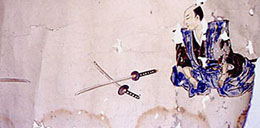 In this regard, almost all the schools connected to Musashi maintain the Chūdan stance of crossed-swords within their Reishiki, when the swords are placed on the ground, and this includes the present-day mainstream line of Noda-ha Niten Ichi-ryū. Additionally, until rather recent times, the Seitō Santō-ha school also maintained this old-style of crossed-sword Reishiki. However, it was modified in the Showa-period to reflect the present use of the Ensō-no-kamae for the Chūdan stance. In this regard, almost all the schools connected to Musashi maintain the Chūdan stance of crossed-swords within their Reishiki, when the swords are placed on the ground, and this includes the present-day mainstream line of Noda-ha Niten Ichi-ryū. Additionally, until rather recent times, the Seitō Santō-ha school also maintained this old-style of crossed-sword Reishiki. However, it was modified in the Showa-period to reflect the present use of the Ensō-no-kamae for the Chūdan stance.
Realistically, it makes little sense that, more than a decade after attaining the ultimate way of Hyōhō, and following a lifetime of using a combative methodology of Enkyoku-no-kamae, which not only befuddled opponents but obviously worked, Musashi suddenly opted to discard it within the most paramount and fundamental Chūdan stance.
As mentioned in the introduction, the abovementioned is the premise put forward by some proponents of the open guard of Ensō-no-kamae within Niten Ichi-ryū when confronted with the obvious or stark variation between the two versions. And, thereafter, surmising why the two swords are no longer crossed despite the clear preponderance of evidence which suggests that Musashi most certainly did use and teach a crossed-sword guard within the Chūdan stance of Niten Ichi-ryū, and not an open guard or Ensō-no-kamae.
Undeniably, the unacknowledged problem for proponents of Ensō-no-kamae is always going to be the progenitor of both present-day transmissions of Santō-ha and Noda-ha Niten Ichi-ryū, Terao Kumenosuke’s own written description for the Chūdan stance in Hyōhō 39. Although written more than 20 years after Musashi’s passing, Kumenosuke’s transmission document clearly indicates that one should adopt and use a crossed-sword guard within the Chūdan stance.

Why the change?
The reality is that, within all Koryū transmissions, things do change and evolve; not only the shapes and techniques, but also the training methodologies have likely changed too. In the same way, how Musashi taught 400 years ago and, for example, in Gorin-no-Sho, expounded to his disciples on how to master his strategy of the two-swords, it wasn’t just the katageiko of five Nitō forms; they are just the starting point and the surface of the mountain, which, in accord with Musashi’s philosophy, we’re seeking to enter deeply into and ultimately through.
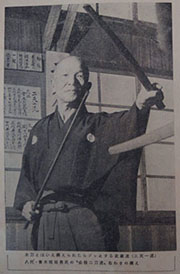 Similarly, in a 1957 article interview with the Seitō Santō-ha Hyōhō Niten Ichi-ryū’s 8th generation headmaster, Aoki Kikuo sōke stated ‘... ニ刀の型が五つある。だが、これはあくまで初歩の基本型であり、あとは敵に応じて自由自在に変化する使い方をする。’ (‘... there are five patterns of Nitō. However, these are just basic patterns in the initial phase, after that you can use them in the way that changes freely adjusting to the enemy.’). Similarly, in a 1957 article interview with the Seitō Santō-ha Hyōhō Niten Ichi-ryū’s 8th generation headmaster, Aoki Kikuo sōke stated ‘... ニ刀の型が五つある。だが、これはあくまで初歩の基本型であり、あとは敵に応じて自由自在に変化する使い方をする。’ (‘... there are five patterns of Nitō. However, these are just basic patterns in the initial phase, after that you can use them in the way that changes freely adjusting to the enemy.’).
This is why there are numerous differences within the several present-day lines of Niten Ichi-ryū and variations in their representative five Nitō kata, including differences in the teachings or curriculum and kata of Aoki sōke’s pre-WW2 and post-WW2 students. Plus, the real nature of Musashi’s teachings, as outlined in the 1638 Heihō-kakitsuke, was such that kamae, like those within the Chūdan stance are, in fact, highly situational; in that document Musashi describes three different versions or positions regarding the initial guard of the two-swords within the Chūdan stance.
On the issue of why this key fundamental and paramount stance would be changed or modified, there is a possibility it was done to hide the combat methodology and logic of Enkyoku-no-kamae’s crossed-swords from outsiders.
Ultimately, to comprehend this hypothesis, it’s very important to understand the riai (underlying rationale) and efficacy of the crossed-sword guard compared to uncrossed or separated swords. And thereafter, to consider the strategic advantage to hiding it from outsiders; concealing such crucial riai and ultimate teachings is commonplace within koryū transmissions even though Musashi was critical, and maintained the futility, of hiding such things.
To begin to make sense of this possibility, we should look at other schools and their teachings in how to deal with a Nitō wielding opponent and a Chūdan crossed-sword guard. Within Shintō Musō-ryū’s Jōjutsu teachings, one aspect is to initially break the crossed guard from above by striking at it (and the head simultaneously, given the length of the Jō), and subsequently applying a counter technique or sequence following the Nitō practitioner’s attempts to apply their follow-on move. A similar teaching, within Yagyū Shinkage-ryū, also instructs an Ittō exponent to strike at the crossed area to assess the opponent’s next move and then also endeavour to counter it.
However, from the Nitō exponent’s perspective, at the strategic level within combat, the fundamental basis of the crossed-sword guard is this exact point: to draw an Ittō opponent into striking at the crossed tips on the centreline being presented as a seemingly impenetrable barrier and, through the initiative of offensive forward pressure, lead them into entrapment by just separating, allowing the strike to enter into the void, and immediately re-joining the swords, thereby gaining control of the opponent’s sword using Jūji waza [13].
This then allows the Nitō exponent to continue to press forward, taking further the initiative of forward movement so as to decisively strike, having touched, grazed or ridden the opponent’s sword. Once entrapped, the opponent’s ability to use their sword freely is severely reduced and their options are limited substantially.
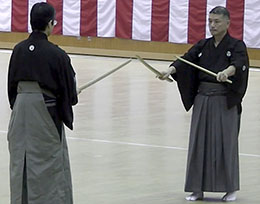 Conversely, with the swords held uncrossed and separated, as in Ensō-no-kamae, there is nothing to break and no incentive to strike towards the centreline situated between the tips and, consciously, enter the void as represented within the kata teachings of both Santō-ha and Noda-ha Niten Ichi-ryū. The Ittō opponent is free to take the initiative in a variety of ways, even if the Nitō exponent attempts to pressure them with the tips of both swords. Without the disconcertion of a seemingly impenetrable physical barrier, the Ittō opponent can just seek to parry either sword or both in rapid succession: the protruding long sword's mune then short sword. Or gain unhindered access between them, penetrating more readily to vital areas like the interior of the wrists and forearms, and even the body. They can also aptly endeavour to focus solely on the long sword, enter down the Nitō opponent’s right side, outside the long sword and negating the short sword, gaining a position that a Nitō practitioner should always attempt to prevent. Conversely, with the swords held uncrossed and separated, as in Ensō-no-kamae, there is nothing to break and no incentive to strike towards the centreline situated between the tips and, consciously, enter the void as represented within the kata teachings of both Santō-ha and Noda-ha Niten Ichi-ryū. The Ittō opponent is free to take the initiative in a variety of ways, even if the Nitō exponent attempts to pressure them with the tips of both swords. Without the disconcertion of a seemingly impenetrable physical barrier, the Ittō opponent can just seek to parry either sword or both in rapid succession: the protruding long sword's mune then short sword. Or gain unhindered access between them, penetrating more readily to vital areas like the interior of the wrists and forearms, and even the body. They can also aptly endeavour to focus solely on the long sword, enter down the Nitō opponent’s right side, outside the long sword and negating the short sword, gaining a position that a Nitō practitioner should always attempt to prevent.
The absence of a crossed-sword guard with its riai (underlying rationale) means the likelihood of drawing the Ittō opponent into striking at the centreline crossed area of an impenetrable barrier, and thereby becoming trapped with Jūji waza, wanes. Also, when Ittō and Nitō opponents each take chūdan-no-kamae, the crossed guard with left foot forward presents the outside of the left hand wielding the short sword as the closest, unprotected target for the Ittō opponent to strike, and thereby, most importantly, draws and keeps the Ittō opponent on the Nitō exponent’s own left side.
Therefore, hiding these crucial Nitō combat methods and riai from outsiders by outwardly presenting Ensō-no-kamae or an open guard stance within the kata would maintain the strategic and combative advantage when adopting Enkyoku-no-kamae in any potential Shinken-shōbu and Taryū-jiai (Taryū-shiai) [14].
Of course, another possibility for the evolvement of the Chūdan stance into Ensō-no-kamae is that of a spiritual and/or state-of-mind basis, as the focus shifted away from a pragmatic combative or functional need to one with a greater emphasis on Seishin and Mushin. In this regard, a key axiom of Musashi, and a core belief within the teachings in Niten Ichi-ryū, is the founders phrase left for posterity of ‘Jissō Enman no Hyōhō’ (実相円満之兵法) [15].
Enman is a Buddhist concept based on a ‘circle that is full’ as a representation of perfect fulfilment or completion. Also, Enkyoku, which is often just translated as ‘circle’, uses a similar concept, although it could be interpreted and rather translated as a ‘circle that is complete’. In Buddhism, Enkyoku (Engoku) at one level represents ‘inclusive to the uttermost’, possibly to convey a functional or conceptual representation of ‘to the highest degree [the two swords] as part of the whole’. However, Enkyoku at another level represents ‘absolute perfection’ and the ultimate truth of completeness that is reality beyond dualism [left/right, short/long] of any kind, which in this case could relate to the substance and ideal use of the dual swords as well as a state-of-mind [16].
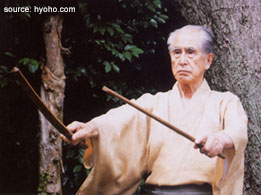 Comparatively, Ensō is a clear unambiguous symbol in the Zen school of Buddhism based on the concept of no-mind as a reflection in the perfection of a circle’s shape, most often represented with a small opening. The late Imai Masayuki sōke, Seitō Santō-ha’s 10th generation headmaster, has explained that Ensō-no-kamae is a guard that reflects a calm and broad mind that contains an entire universe between the two swords. Comparatively, Ensō is a clear unambiguous symbol in the Zen school of Buddhism based on the concept of no-mind as a reflection in the perfection of a circle’s shape, most often represented with a small opening. The late Imai Masayuki sōke, Seitō Santō-ha’s 10th generation headmaster, has explained that Ensō-no-kamae is a guard that reflects a calm and broad mind that contains an entire universe between the two swords.
So, it is possible that this focus on Ensō-no-kamae, with an opening between the separated two swords, is a result of a preferred focus of Musashi's successors on the Zen Buddhist aspect of no-mind within the Chūdan-no-kamae.
From a personal perspective, having been exposed to the techniques and teachings of both types of Chūdan-no-kamae, I feel they’re not as distinct or separate as is often considered and suggested within the different schools of thought, and they do actually share a close relationship and connection.
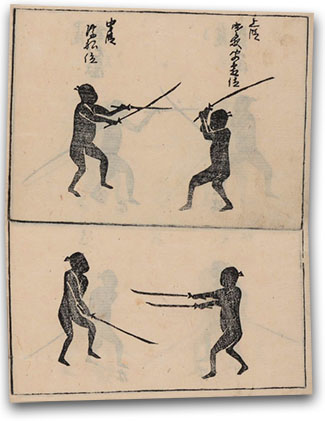 In this regard, the crossed swords of Enkyoku-no-kamae when struck at by an opponent can be separated using a technique like Taka-no-ha (Hawk’s wings), and as part of that transition the swords do end up in the open Ensō-no-kamae. Also, within more than one Owari Enmei-ryū form, after initially entrapping uchidachi’s sword and the subsequent escape by uchidachi, shidachi steps forward and the open points of the swords are purposefully pressed towards the face, in an almost identical position as Ensō-no-kamae, to disconcert them and pressure them into their next strike [17]. In this regard, the crossed swords of Enkyoku-no-kamae when struck at by an opponent can be separated using a technique like Taka-no-ha (Hawk’s wings), and as part of that transition the swords do end up in the open Ensō-no-kamae. Also, within more than one Owari Enmei-ryū form, after initially entrapping uchidachi’s sword and the subsequent escape by uchidachi, shidachi steps forward and the open points of the swords are purposefully pressed towards the face, in an almost identical position as Ensō-no-kamae, to disconcert them and pressure them into their next strike [17].
Furthermore, within Niten Ichi-ryū, the separated swords are also often crossed in waza called Jūjidome in both the Gedan and Jōdan positions, and this waza at the Chūdan level is really just Enkyoku-no-kamae [13].
Interestingly, in Heihō-kakitsuke’s description of Gedan, there seems to be two related variations as well. One appears to be a crossed-sword Gedan position such as pictured in the 1769 scroll, and there’s also another description which appears to be with the sword tips open as is represented in Musashi’s own self-portrait.
In the end, Musashi’s ‘Teaching of the Guard without a Guard’ in Gorin-no-Sho would imply that these Chūdan positions and variations of Enkyoku-no-kamae and Ensō-no-kamae, like the other stances, should ultimately be viewed as situationally adaptive anyway, and were never intended to be fixed positions per se, or labels, to be attached to.
Therefore, what is truly most important, and in line with Musashi’s actual teachings and philosophy, is to endeavour to gain unclouded insight and understanding into the function and substance of each stance or guard and variation situationally, and thereby apply the ideal one for a particular circumstance. And in this way seek, ultimately, to manifest wisdom in Musashi’s ‘Jissō Enman no Hyōhō’ [15].
No part of this material may be reproduced in any form or by any means, electronic or mechanical, including photocopy, without permission in writing from Kobudōkai Australia. However, you are welcome to share a link to this article on such social media as Facebook, Instagram or Twitter.

Footnotes:
|







